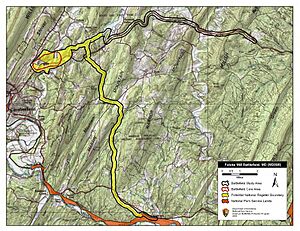Battle of Folck's Mill facts for kids
Quick facts for kids Battle of Folck's Mill |
|||||||
|---|---|---|---|---|---|---|---|
| Part of the American Civil War | |||||||
|
|||||||
| Belligerents | |||||||
| Commanders and leaders | |||||||
| Benjamin F. Kelley | John McCausland | ||||||
| Strength | |||||||
| three regiments | two brigades | ||||||
| Casualties and losses | |||||||
| 2 killed 3 Wounded |
20-25 killed 40-50 wounded |
||||||
The Battle of Folck's Mill, also called the Battle of Cumberland, was a small fight during the American Civil War. It happened on August 1, 1864, in northern Maryland. This battle was part of the larger Valley Campaigns of 1864. It was mainly a clash between groups of soldiers on horseback, known as cavalry.
Contents
A Bold Plan by Confederate Cavalry
After burning a town called Chambersburg, Pennsylvania, on July 30, 1864, some Confederate cavalry units moved towards western Maryland. These units were led by generals John McCausland and Bradley T. Johnson. Their main goal was to cause trouble for the Baltimore and Ohio (B&O) Railroad. They also planned to demand money from the town of Cumberland or burn it down.
On August 1, around 3 p.m., the Confederate soldiers reached Folck's Mill. This place was just east of Cumberland. There, they met Union forces led by Brigadier General Benjamin F. Kelley. General Kelley had three groups of soldiers. These were "100-days troops," who were new and hadn't fought much. He also had six cannons ready for battle.
The Fight at Folck's Mill
As the Confederates got close to Cumberland, General Kelley's cannons started firing at them. The Confederate leader, McCausland, didn't know the area well. He also wasn't sure how strong the Union forces were. So, he decided not to charge forward right away. Instead, he brought up his own cannons.
The cannons from both sides then fired at each other for several hours. This "artillery duel" lasted until about 8 p.m. After that, McCausland decided to pull his troops back. They headed southeast towards Old Town, which is on the Potomac River.
Crossing the Potomac River
The next day, the Confederates planned to cross the Potomac River into West Virginia. But they found a problem. The bridges over the Chesapeake and Ohio Canal had been burned. Colonel Israel Stough and his "100-days troops" had burned them. Colonel Stough's soldiers were positioned between the canal and the river. They were ready to stop the Confederates from moving forward.
The Confederates tried to charge, but Stough's men pushed them back at first. However, a group called the 21st Virginia managed to build a bridge. They crossed the canal on the left side of Stough's position. This forced Stough's Union troops to retreat across the Potomac River.
On the south side of the river, the Union soldiers found cover. Some went into a small fort called a blockhouse on the B&O Railroad line. Others got onto an armored train that was stopped on the tracks. This train was operated by the Potomac Home Brigade.
McCausland thought about attacking the blockhouse directly. But he decided it was smarter to ask them to surrender first. The Union soldiers inside the blockhouse agreed to surrender. After this, the Confederates crossed the river. They then went to Springfield, West Virginia, where they rested until August 4.
Why This Battle Mattered
Even though the fighting around Cumberland didn't have a clear winner, General Kelley's actions were very important. His stand likely saved Cumberland from being burned. It also helped protect the railroads from more damage. Colonel Stough's strong resistance at the Potomac River was also significant. It was the first time McCausland's Confederate forces had faced such a determined fight since they burned Chambersburg.
Union Forces
Here are some of the Union forces involved in the battle:
- 153rd Ohio National Guard: Led by Colonel Israel Stough
- 156th Ohio National Guard: Led by Colonel Caleb Marker
- 11th West Virginia Infantry, 4 Companies: Led by Major J. L. Simpson
- 1st Illinois Light Artillery, Battery L: Led by Lieutenant J. McAfee
- 2nd Potomac Home Guard Maryland Infantry: Led by Captain Petrie


